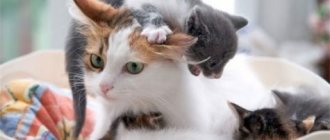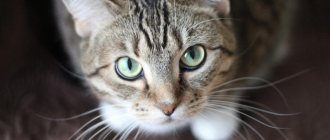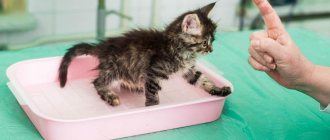Changes in the color of the skin, mucous membranes and eye membranes indicate the development of such a symptom of damage to the body as jaundice in a cat. Diseases develop as a result of internal pathological processes, external toxic effects or violations of the regime of keeping and feeding the animal. This condition requires immediate attention to a veterinarian. The disease is not contagious to humans and cannot be transmitted from animals.
Types of jaundice in cats
- Mechanical - occurs as a result of blockage of the liver ducts, gall bladder or excretory ducts by a foreign body, parasites or tumors. Due to a violation of the outflow, bile does not enter the intestines, being absorbed directly into the blood.
- Parenchymal - occurs when the functioning of liver cells is disrupted, because of this, its work is disrupted and bilirubin is released into the blood.
- Hemolytic - occurs with excessive destruction of red blood cells, which causes increased formation of bilirubin outside the liver.
What is bilirubin?
This is a bile pigment, which is formed after the breakdown of proteins, and contains the iron-containing fraction of heme - cytochrome cells, myoglobin and hemoglobin. As a result of breakdown, it is normally utilized through the liver, from there it enters the intestines along with bile and is excreted along with feces. Filtration also occurs in the kidneys.
There are two types of bilirubin - direct and indirect. Indirect is formed precisely at the moment of breakdown of red blood cells and is toxic to the body. Direct is formed after neutralization of unbound in the liver. It is slightly toxic and has the property of soluble in water.
Prognosis and care for a sick animal
The prognosis for this disease mainly depends on the underlying cause and the proposed treatment. However, a proper diet, timely administration of medications, rest and supervision by a veterinarian will help your cat quickly restore its compromised health. Do not give medications or change their dosage without your veterinarian's approval. This especially applies to analgesics, which under normal conditions can be toxic to the liver, and in this case can even lead to the death of the animal. By the way, how to treat jaundice? Only a veterinarian should think about this, as your intervention could end very sadly!
Cats with liver failure need careful care from their owners, as their condition is extremely serious. At any time of the day or night, emergency veterinary attention may be required. If you see any signs of worsening, call a specialist immediately. This is especially true in cases where your pet's urine or feces have suddenly changed color. This indicates a sharp deterioration in the cat's condition. For example, the gallbladder could rupture: if you don’t immediately take the animal to the clinic, everything will end very badly!
It should be noted that in most cases, complete recovery cannot be achieved. The consequences remain forever. Therefore, the diet of a cat after jaundice is extremely important. How is it characterized? A small amount of fat, balanced in all essential minerals and vitamins... Simply put, inexperienced breeders would be better off purchasing special food for cats with kidney failure. If you do not have this opportunity, be sure to consult with a veterinarian who can create a professional, balanced diet for your sick pet.
Jaundice is the sudden yellowing of a cat's eyeballs, skin and tissues, gums and tongue. Unlike other infectious and non-infectious diseases, jaundice in cats is quite rare. As a rule, it is a sign of a large number of pathologies. So, why is such jaundice dangerous and how does it manifest itself?
Causes
In most cases, the cause of jaundice in cats is liver damage. There are many factors that are accompanied by icterus (yellowness) of the skin and mucous membranes. Causes of parenchymal jaundice:
- Idiopathic familial hepatitis.
- Viral hepatitis.
- Cirrhosis and necrosis of the liver.
- Systemic diseases – leptospirosis, hypothyroidism, feline viral immunodeficiency.
- Sepsis.
- Lymphoma.
- Toxic liver damage - most common - from medications (paracetamol)
Factors that cause hemolytic jaundice include:
- Systemic diseases – lupus erythematosus.
- Viral infections – babesiosis, dirofilariasis, cytozoonosis, feline leukemia virus.
- Extensive hematomas.
The occurrence of obstructive jaundice is characterized by the following diseases:
- Pancreatitis.
- Formation of stones in the gall bladder.
- Parasites – opisthorchiasis, liver flukes.
- Cholangitis and bile duct defects.
- Damage to the integrity of the gallbladder.
There are also risk factors that can very often lead to the above diseases, and, consequently, jaundice.
The main risk factor in cats is obesity. It can lead to disruption of the functioning of the pancreatic gland and fatty liver changes. Jaundice also begins with sudden weight loss in obese cats, due to liver lipidosis.
Jaundice can be caused by hemolytic anemia, injudicious use of medications and trauma.
Prevention
Jaundice is a symptom of a large number of diseases. It is not those cats that are infected with something that get sick, but animals with reduced immune defenses. Animals that eat nutritious food and live in a comfortable environment are less likely to get sick. To maintain immune defenses, cats are regularly dewormed, skin parasite free, and vaccinated.
Jaundice is a symptom of infectious and non-communicable diseases. Concomitant factors for the occurrence of the disease are unbalanced feeding and unsatisfactory maintenance. Leptospirosis is considered a common disease for humans and cats.
We invite you to join our Zen channel and group on VKontakte or Odnoklassniki, where new articles for pet owners are published.
Similar articles:
- Ringworm Caution: What Pet Owners Need to Know
- Why are cats overweight?
- Nephritis in cats
Symptoms
Almost all types of jaundice are associated with a persistent increase in bilirubin in the blood serum and its deposition in tissues. Clinical signs of jaundice are associated with this feature of the development of the disease process.
The skin is yellow in color - from pale straw to saffron. The mucous membranes and sclera of the eyes are also stained. In cats, this symptom is most noticeable on the auricle and oral mucosa; the whites of the eyes can remain normal color for a long time.
Due to the high toxicity of indirect bilirubin, an increase in its concentration in the blood leads to severe disorders of the nervous system - changes in consciousness and degenerative disorders of the brain.
Depending on the causes and type of jaundice, the following symptoms may appear:
- Prehepatic (hemolytic jaundice) – the disease begins abruptly, enlargement of the liver and spleen occurs, anorexia, lethargy. Lymph nodes become enlarged and fever is possible. A change in stool is characteristic - the stool becomes orange.
- Subhepatic (mechanical) – it is characterized by discoloration of feces and dark urine (the color of dark beer). The abdomen enlarges, there is severe pain, weight loss and loss of appetite. Vomiting and diarrhea begin.
- Hepatic (parenchymal) - enlarged liver, dark brown urine and light-colored feces. General health changes, weight loss, polyuria and increased thirst. Ascites or abdominal effusion may occur. Due to brain damage, behavior changes - aggression, disorientation, ptyalism (increased salivation).
Need to know
To the question “How quickly does jaundice go away in cats?” it is difficult to give a definite answer. But timely treatment and good care will help defeat the disease in a short time. Cat owners can sleep peacefully, since jaundice in animals is not contagious to humans. The only disease that can be transmitted to humans is leptospirosis, which causes jaundice. It is transmitted through the feces and urine of a sick cat. So be extremely careful.
A great way to prevent disease is prevention:
- proper and balanced nutrition;
- body weight control; it is important to prevent your pet from becoming obese;
- vaccination;
- carrying out antihelminthic therapy at least twice a year;
- regular visits to the veterinarian;
- taking vitamin complexes.
Pets need not only to be loved, but also to be properly cared for.
The disease is characterized by yellowing of the tissues and gums due to a high concentration of bilirubin, a bile pigment. Jaundice in cats is one of those ailments that cannot be completely cured. Its consequence may even be lethargy. So, let’s learn in detail about this disease, its symptoms, diagnosis, and prognosis.
Diagnostics
One of the first diagnostic methods is to take a blood test, which determines the presence of inflammation, anemia and altered red blood cells. It is also necessary to take a biochemical analysis to determine liver enzymes (ALT, AST and alkaline phosphatase). The level of direct and total bilirubin is also assessed.
Normal indicators in cats: ALT – from 19 to 78 units/l, AST – from 9 to 30 units/l, Bilirubin – from 2 to 16 µmol/l
A urine test also evaluates the presence of bilirubin and urobilinogen.
Blood smears are performed to determine parasites, as well as serological tests for feline immunodeficiency viruses, leukemia and leptospirosis.
If effusion or ascites is present, fluid analysis is performed.
To examine the liver, ultrasound is used, as well as radiography - it determines the presence of fluid, enlargement of the liver or spleen, as well as metastases or tumors.
Sometimes it is necessary to perform a liver biopsy and bile collection for bacteriological and cytological analysis.
For prehepatic jaundice, a blood clotting test (prothrombin index), an immune-mediated hemolytic anemia test, and a water-salt test (to determine the agglutination (clumping) of red blood cells) are performed.
How long does it take to treat hepatitis, what are the possible complications?
Hepatitis, as a rule, does not go away quickly. With timely treatment, when treatment begins in the early stages of the disease, improvement occurs after 7–14 days. However, the duration of therapy depends not only on timely measures taken, but also on the pet’s immunity, its age, and the type of pathogen. You cannot treat animals for jaundice on your own. Prescriptions are made only by a veterinarian, based on test results and the condition of the cat.
The risk of developing complications with hepatitis is very high, which is why it is so important to make a correct diagnosis in time. Impaired liver function can lead to the following complications:
- lipidosis – replacement of structural liver cells with adipose tissue due to the fact that the pet does not eat for a long time;
- encephalopathy – brain damage as a result of prolonged intoxication of the body with metabolic products;
- ascites (dropsy) – effusion of lymphatic fluid into the abdominal cavity;
- Cirrhosis is an irreversible pathology in which liver cells are gradually replaced by fibrous ones.
Treatment
All types of jaundice are treated based on the causes of the disease. Before treatment, a complete examination of the cat is required.
Diet
For the hepatic and subhepatic forms, a diet is prescribed using feed with a high content of easily digestible proteins. It is better to use ready-made food that is designed specifically for animals with liver disease. It is worth completely limiting salt, and also adding vitamins to the diet - C, group B, PP. Vitamin K1 is especially important; it is used for blockage of the bile ducts and cholestasis.
Drug therapy
It is important to strictly follow your doctor's recommendations. At the onset of the disease, the animal must be kept in a hospital until the condition stabilizes.
The drugs are used to treat the underlying cause of the disease. For hemolytic jaundice, a transfusion of blood or its components is often prescribed.
All drug treatment includes three main points:
- Etiotropic therapy – drugs that fight the cause of the disease. This could be antibiotics, antitoxic treatment, etc.
- Pathogenetic - which removes damaging factors of the disease, for example, destroyed liver cells, abdominal fluid or anemia.
- Symptomatic – treatment to alleviate the animal’s condition. It includes pain relief, antiemetics, etc.
Mechanical and parenchymal forms of therapy may require surgical treatment. It is possible to remove part of the liver, gall bladder or stones.
What drugs should you avoid:
- Tetracycline antibiotics – they have the property of reducing protein synthesis in the liver and can worsen the cat’s condition.
- If liver failure develops, analgesics and painkillers are excluded from treatment.
- Hepatotoxic drugs - paracetamol, erythromycin, etc.
Do not use medications without a doctor's prescription; most medications are processed in the liver. Therefore, the wrong medication or dosage can lead to liver failure, coma and even death of the pet.
Therapeutic measures
Treatment mainly depends on the underlying cause and is very individual. If the primary disease is very advanced, or the cat’s condition is close to critical, he may have to be hospitalized. In milder cases, a gentle diet is prescribed, the components of which do not put additional stress on the liver. Vitamins and preparations containing iron are often used (since the liver needs to be treated). If the cause of the pathology is a tumor or cyst that compresses the bile ducts, it is unlikely that it will be possible to do without a complex surgical operation. In Western veterinary clinics, blood transfusions are also constantly practiced for jaundice, but in our conditions this happens much less often, since there are no centralized blood banks for animals.











